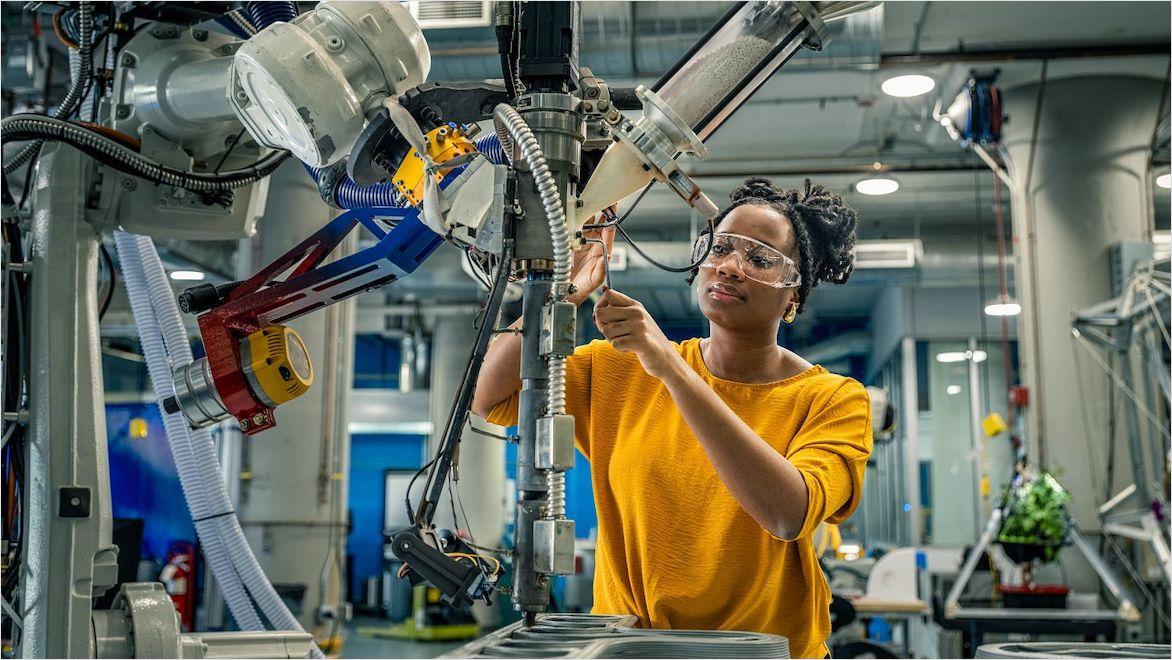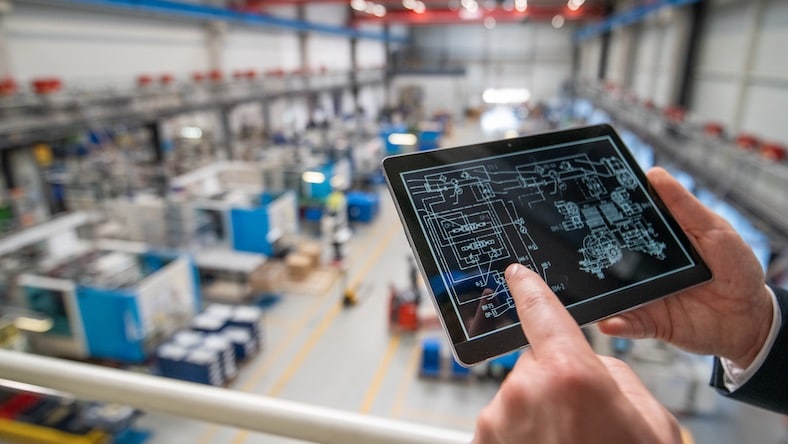& Construction

Integrated BIM tools, including Revit, AutoCAD, and Civil 3D
& Manufacturing

Professional CAD/CAM tools built on Inventor and AutoCAD
Flexible manufacturing systems rely on automation and advanced technology to adapt to changing demands.
A flexible manufacturing system (FMS) is a computer-controlled production setup designed primarily to adapt at any time to changes such as product details, new products, batch sizes, sequence reordering, and so on. An FMS relies on automation as much as possible using advanced technology and flexible manufacturing software, resulting in higher overall quality and productivity, lower costs, and less waste.
Robotics and additive manufacturing are common elements of flexible manufacturing systems.
Industrial engineer and inventor Jerome H. Lemelson pioneered the concept of flexible manufacturing systems in the early 1950s with a series of patents for a robotic production system that would weld, rivet, convey, and inspect products. The concept was not practical until the 1960s but it proliferated in the 1970s. Since then, FMS have become more capable, adaptable, modular, and attainable for smaller-scale businesses. But regardless of the type or scale of FMS being used, the systems are all based on the three components of 1) a centralized computer and software controlling 2) work machines that manipulate 3) materials into parts or products. Elements of FMS include robotics systems for assembly, pick and place, inventory, and more; computer numerical control (CNC) machines and 3D printers; and programmable logic controllers (PLCs).
The “flexible” aspect of flexible manufacturing boils down to either routing flexibility or machine flexibility. Routing flexibility means that a business can rearrange the sequence of a product’s manufacture and assembly to adapt to changing circumstances. So, if a product takes several stages and workstations to completely produce and assemble, the company can re-order the sequence of work to keep production going if a supply disruption or machine maintenance affects one of the stages. With machine flexibility, a manufacturer can produce the same product using different machines, with minimal differences in the quality and details of the product. For example, if one machine needs maintenance or there is a sudden surge in demand, the company can shift production over to another machine or set of machines.
Several types of flexible manufacturing systems have been defined, but in the spirit of flexibility, manufacturers can combine them all as needed. A dedicated FMS focuses on a specific product that is highly specialized, which makes it common in high-performance industries like aerospace. A sequential FMS makes a product or group of products in a specific sequential order, moving from one station to the next. An engineered FMS makes the same part in high volume with high accuracy and is common in the automotive industry. Random FMS is the most common type and can adapt quickly to making different products with different specifications from the same machine or set of machines. Finally, a modular FMS is the most flexible type of system because it combines FMS elements from all the other FMS types to create workstation modules that can be configured, modified, and upgraded to adapt production lines radically using existing equipment.
Many industries like automotive, aerospace, electronics, medical devices, food processing, and others greatly benefit from investing in flexible manufacturing systems.
Remarkable accuracy and reliability from FMS improve quality control and data monitoring can identify and address quality problems quickly. Production is more efficient because very little downtime is needed to set up for different products or product variations.
With the efficiency of FMS, manufacturers can increase margins because they maintain production using fewer resources. Flexible manufacturing systems need skilled, well-compensated workers to maintain, but implementing them can reduce overall labor costs in the long run.
Flexible manufacturing system is less prone to error when it’s part of a connected factory that uses constant data streams from the Industrial Internet of Things (IIoT) to monitor systems and exercise predictive maintenance. Errors that do occur are easier to fix and can be isolated in the FMS so that other parts of the system can continue to run—all leading to less material waste from mistakes and rework.
Before moving forward with flexible manufacturing systems, businesses should understand the significant upfront investment needed to purchase, install, and set up equipment. There may also be a skills gap in the existing workforce, which may require training to get up to speed on the new systems or hiring new engineers and technicians to supplement the workforce. Once running, FMS can also be expensive to maintain and support.
Given those caveats, once manufacturers have bought into flexible manufacturing, they can be more efficient, agile, and less at the mercy of volatile supply chains and demand fluctuations. With FMS in place, changes to product demand and supply chains are more easily handled by adapting production setups to work with different products or assemblies, or to self-produce needed parts.
Professional-grade product design and engineering tools for 3D mechanical design, simulation, visualization, and documentation.
PORSCHE
To make the electric Taycan sportscar, Porsche built an ultra-modern, “zero-impact” flexible manufacturing facility from scratch using Autodesk software.
VIESSMANN
This German heat pump maker employed digital factory planning to build a facility offering flexible modular manufacturing, using Autodesk Inventor to design all the factory processes.
TOYOTA
A longtime advocate of flexible manufacturing, Toyota used generative design in Autodesk Fusion to devise a better seat frame, experimenting with fabrication that combines mass production with 3D printing.
As one of the seven steps toward a digital transformation in manufacturing, flexible manufacturing serves as a bulwark against supply chain disruption, allowing production plans to pivot and parts to be made in-house.
Learn about how creating a digital factory leads to efficiency, sustainability, faster time to market, and flexible manufacturing that can unlock innovation and new revenue streams.
Read up on the planning, data utilization, and cultural shift needed to start or configure a digital factory—the gateway to flexible manufacturing.
Whether it’s a standalone business or a unit of a larger company, a microfactory provides an experimental lab for advanced technology and innovation, as well as a configurable base for the most flexible manufacturing workflows.
Find out how standardizing all your manufacturing software with a single vendor makes your factory more flexible and agile, encouraging simplicity, efficiency, and employee best practices.
Learn how the Fusion industry cloud for manufacturing connects all the stages, data, and people involved with the product lifecycle into a unified yet flexible ecosystem that streamlines workflows with advanced automation and AI.
The primary goal of flexible manufacturing systems is to optimize production efficiency, which includes keeping costs and waste as low as possible. FMS addresses productivity by making factory operations quickly adaptable to fluctuations in the supply chain, customer demand, and other priorities so efficient production can continue unabated. FMS derives much of its efficient adaptability from utilizing robotics, CNC machines, automated data collection and processing, and other software-controlled automation.
The pros of flexible manufacturing systems are improvements to productivity, quality control, and safety, while reducing errors, waste, and costs in the long run.
On the cons side, FMS requires a sizable initial investment of both money and time to purchase, install, and set up the systems, as well as deliver critical training to employees. FMS can also be expensive to maintain and support.
A classic example of a flexible manufacturing system is a robotic assembly line in an automotive plant. However, there are many more recent examples that make manufacturing operations even more flexible. Robotic systems fit the description, whether they perform welding, painting, assembly, or pick-and-place robots that move things from one station to another or work in inventory.
FMS also includes CNC machines and additive manufacturing (3D printing) machines, used for rapid prototyping or making final production parts. Other smaller FMS examples include automated guided vehicles (AGVs) that move items without human aid and programmable logic controllers (PLCs), which control aspects of a particular machine or a larger system.
The three major components of an FMS are parts/materials, centralized computing, and work machines. The availability of materials and/or parts affects the workflows coming from a central computer system, where cloud-powered software and data analysis control the jobs being sent to the factory’s CNC machines and other computer-controlled fabrication machines.




